A Chaotic Genetic Algorithm with Variable Neighborhood Search for Solving Time-Dependent Green VRPTW with Fuzzy Demand
Abstract
1. Introduction
- Considering the time dependence of vehicle speed and the relationship between fuel consumption and vehicle type, speed, load, and road gradient, based on fuzzy credibility theory, a fuzzy chance-constrained programming model is formulated to minimize the total cost to optimize the vehicle routing with fuzzy demand.
- Chaotic genetic algorithm with variable neighborhood search and re-dispatch strategy is developed to solve the proposed problem. In the algorithm, the Logistic chaotic map is used to generate the initial population, and an adaptive neighborhood search strategy and an inferior solution acceptance mechanism are proposed.
2. Problem and Mathematical Model
2.1. Problem Description
2.2. Time-Dependent Function of Vehicle Speed
2.3. Calculation of Fuel Consumption
2.4. Pre-Optimization Stage
2.4.1. Fuzzy Demand Measure
2.4.2. Mathematical Model
2.5. Re-Dispatch Strategy
- (1)
- Failure node return strategy: As shown in Figure 2b, when the vehicle fails to serve customer 3, the vehicle returns to the depot to be reloaded and then continues to visit customer 3 and its subsequent customers according to the pre-optimization scheme, the same is true for customer 7.
- (2)
- Pre-failure node return strategy: As shown in Figure 2c, Before the vehicle visits customer 3, the credibility that the remaining load of the vehicle meets the demand of customer 3 is pre-judged, and when the credibility is less than the preset value, the vehicle returns to the depot for loading and then visits according to the pre-optimized route.
3. Solution Methodology
3.1. Generation of the Initial Population
- (1)
- Setting parameters: population size is , chromosome length is , logistic chaotic mapping coefficient is .
- (2)
- The initial values of logistic chaotic maps are randomly generated.
- (3)
- The chaotic system of groups (each group consists of values) is calculated by Equation (20).
- (4)
- The initial population is generated according to the positions of values in the chaotic system within their respective groups.
3.2. Fitness Function
3.3. Select Operation
3.4. Evolutionary Operation
3.5. Local Search Strategy
3.5.1. Neighborhood Structure
- (1)
- Insert: Randomly select customers and , and insert customer after customer . As shown in Figure 7a, customer 3 is inserted after customer 6.
- (2)
- Exchange: Randomly select customers and , then their positions are exchanged. As shown in Figure 7b, customer 3 and customer 6 are exchanged their locations.
- (3)
- 2-OPT: Randomly select customers and , and the order of other customers among them are exchanged. As shown in Figure 7c, the position of customer 3 is kept unchanged, and customers 4, 5, 7, and 6 are in reverse order.
3.5.2. Adaptive Mechanism and Solution Acceptance
4. Instance Verification and Result Analysis
4.1. Algorithm Test
4.1.1. Instance Analysis of VRPTW
4.1.2. Instance Analysis of VRPFD
4.2. Numerical Experiment
4.2.1. Pre-Optimization Stage
4.2.2. Re-Optimization Stage
5. Conclusions
- (1)
- The fuzzy chance-constrained optimization model of TDGVRPTWFD has fully considered the fuzziness of customer demand in the actual distribution process, further expanding and deepening the VRP research.
- (2)
- The model considers the time-dependent vehicle speed and the influence of vehicle speed, load, and road gradient on fuel consumption. After considering the above factors, the model becomes more complex and closer to the actual situation.
- (3)
- The proposed algorithm uses logistic chaotic mapping to generate initial solutions, which ensures the diversity of initial solutions. Adaptive neighborhood search times strategy and inferior solution acceptance mechanism improve the performance of algorithm.
- (4)
- In the pre-optimization stage, the distribution costs of the pre-optimization scheme increase with the increase of the preference value of decision-makers, and the number of vehicles dispatched also increases. In the re-optimization stage, the more conservative the decision-makers tend to be, the lower the extra costs they pay and the smaller the number of vehicles they dispatch.
Author Contributions
Funding
Institutional Review Board Statement
Informed Consent Statement
Data Availability Statement
Conflicts of Interest
References
- Cao, E.; Lai, M. The open vehicle routing problem with fuzzy demands. Expert Syst. Appl. 2010, 37, 2405–2411. [Google Scholar] [CrossRef]
- Kuo, R.J.; Zulvia, F.E.; Suryadi, K. Hybrid particle swarm optimization with genetic algorithm for solving capacitated vehicle routing problem with fuzzy demand-A case study on garbage collection system. Appl. Math. Comput. 2012, 219, 2574–2588. [Google Scholar] [CrossRef]
- Wang, J.; Li, B. Dynamic management of vehicle routing problem with time windows and fuzzy demands based on the multi-objective optimization. Chinese J. Manag. 2013, 10, 238–243. [Google Scholar]
- Liu, C.S.; Kou, G.; Huang, F.H. Vehicle coordinated strategy for vehicle routing problem with fuzzy demands. Math. Probl. Eng. 2016, 9, 9071394. [Google Scholar] [CrossRef]
- Zhang, X.N.; Fan, H.M. Optimization and real-time adjustment for vehicle routing problem with fuzzy demand. Shanghai Jiaotong Univer. 2016, 50, 123–130. [Google Scholar]
- Li, Y.; Fan, H.M.; Zhang, X.; Yang, X. Two-stage variable neighborhood tabu search for the capacitated vehicle routing problem with fuzzy demand. Syst. Eng. Theory Pract. 2018, 38, 522–531. [Google Scholar]
- Giallanza, A.; Li Puma, G. Fuzzy green vehicle routing problem for designing a three echelons supply chain. J. Clean Prod. 2020, 259, 120774. [Google Scholar] [CrossRef]
- Fan, H.; Li, D.; Kong, L.; Ren, X. Optimization for time dependent vehicle routing problem with fuzzy demand and time windows. Con. Theory Appl. 2020, 37, 950–960. [Google Scholar]
- Hashimoto, H.; Yagiura, M.; Imahori, S.; Ibaraki, T. Recent progress of local search in handling the time window constraints of the vehicle routing problem. Ann. Oper. Res. 2010, 8, 221–238. [Google Scholar] [CrossRef]
- Yu, Y.; Wang, S.H.; Wang, J.W.; Huang, M. A branch-and-price algorithm for the heterogeneous fleet green vehicle routing problem with time windows. Transp. Res. Pt. B Methodol. 2019, 122, 511–527. [Google Scholar] [CrossRef]
- Wang, Y.; Wang, L.; Chen, G.C.; Cai, Z.Q.; Zhou, Y.Q.; Xing, L.N. An improved ant colony optimization algorithm to the periodic vehicle routing problem with time window and service choice. Swarm Evol. Comput. 2020, 55, 100675. [Google Scholar] [CrossRef]
- Marinakis, Y.; Marinaki, M.; Migdalas, A. A multi-adaptive particle swarm optimization for the vehicle routing problem with time windows. Inf. Sci. 2019, 481, 311–329. [Google Scholar] [CrossRef]
- Perez-Rodríguez, R.; Hernandez-Aguirre, A. A hybrid estimation of distribution algorithm for the vehicle routing problem with time windows. Comput. Ind. Eng. 2019, 130, 75–96. [Google Scholar] [CrossRef]
- Taniguchi, E.; Shimamoto, H. Intelligent transportation system based dynamic vehicle routing and scheduling with variable travel times. Transp. Res. Pt. C-Emerg. Technol. 2014, 12, 235–250. [Google Scholar] [CrossRef]
- Mancini, S. Time dependent travel speed vehicle routing and scheduling on a real road network: The case of Torino. Transp. Res. Procedia 2014, 3, 433–441. [Google Scholar] [CrossRef]
- Haghani, A.; Jung, S. A dynamic vehicle routing problem with time-dependent travel times. Comput. Oper. Res. 2005, 32, 2959–2986. [Google Scholar] [CrossRef]
- Hashimoto, H.; Yagiura, M.; Ibaraki, T. An iterated local search algorithm for the time-dependent vehicle routing problem with time windows. Discret. Optim. 2008, 5, 434–456. [Google Scholar] [CrossRef]
- Hu, C.; Lu, J.; Liu, X.; Zhang, G. Robust vehicle routing problem with hard time windows under demand and travel time uncertainty. Comput. Oper. Res. 2018, 94, 139–153. [Google Scholar] [CrossRef]
- Figliozzi, M.A. The time dependent vehicle routing problem with time windows: Benchmark problems, an efficient solution algorithm, and solution characteristics. Transp. Res. Pt. E-Logist. Transp. Rev. 2012, 48, 616–636. [Google Scholar] [CrossRef]
- Mu, D.; Wang, C.; Wang, S.C.; Zhou, S.C. Solving TDVRP based on parallel-simulated annealing algorithm. Comput. Int. Manuf. Syst. 2015, 21, 1626–1636. [Google Scholar]
- Kuo, Y.Y. Using simulated annealing to minimize fuel consumption for the time-dependent vehicle routing problem. Comput. Ind. Eng. 2010, 59, 157–165. [Google Scholar] [CrossRef]
- Liu, C.S.; Kou, G.; Zhou, X.C.; Peng, Y.; Sheng, H.F.; Alsaadi, F.E. Time-dependent vehicle routing problem with time windows of city logistics with a congestion avoidance approach. Knowl.-Based Syst. 2020, 188, 104813. [Google Scholar] [CrossRef]
- Poonthalir, G.; Nadarajan, R. A fuel efficient green vehicle routing problem with varying speed constraint (F-GVRP). Expert Syst. Appl. 2018, 100, 131–144. [Google Scholar] [CrossRef]
- Xu, Z.; Elomri, A.; Pokharel, S.; Mutlu, F. A model for capacitated green vehicle routing problem with the time varying vehicle speed and soft time windows. Comput. Ind. Eng. 2019, 137, 106011. [Google Scholar] [CrossRef]
- Xiao, Y.; Konak, A. The heterogeneous green vehicle routing and scheduling problem with time-varying traffic congestion. Transp. Res. Pt. E-Logist. Transp. Rev. 2016, 88, 146–166. [Google Scholar] [CrossRef]
- Çimen, M.; Soysal, M. Time-dependent green vehicle routing problem with stochastic vehicle speeds: An approximate dynamic programming algorithm. Transp. Res. Part D-Transp. Environ. 2017, 54, 82–98. [Google Scholar] [CrossRef]
- Yang, H. Research of Urban Recurrent Congestion Evolution based on Taxi GPS Date. Doctoral Thesis, Harbin Institute of Technology, Harbin, China, 2018. [Google Scholar]
- Hickman, J.; Hassel, D.; Joumard, R.; Samaras, Z.; Sorenson, S. MEET Methodology for Calculating Transport Emissions and Energy Consumption; Technical Report DG VII; European Commission: Brussels, Belgium, 1999. [Google Scholar]
- Alinaghian, M.; Naderipour, M. A novel comprehensive macroscopic model for time-dependent vehicle routing problem with multi-alternative graph to reduce fuel consumption: A case study. Comput. Ind. Eng. 2016, 99, 210–222. [Google Scholar] [CrossRef]
- Cao, E.B.; Lai, M.Y. A hybrid differential evolution algorithm to vehicle routing problem with fuzzy demands. J. Comput. Appl. Math. 2009, 231, 302–310. [Google Scholar]
- Yang, W.; Mathur, K.; Ballou, R.H. Stochastic vehicle routing problem with restocking. Transp. Sci. 2000, 34, 99–112. [Google Scholar] [CrossRef]
- Xie, B.L.; An, S.; Guo, Y.H. Multi-tour optimization policy for stochastic vehicle routing problem. Syst. Eng. Theory Prac. 2007, 27, 167–171. [Google Scholar]
- Zhao, Y.; Li, C.; Zhang, J.; Lu, Y.; Wang, W. Novel algorithm for multi-objective vehicle routing problem with stochastic demand. Comput. Integr. Manuf. Syst. 2012, 18, 523–530. [Google Scholar]
- Fan, H.M.; Liu, P.C.; Liu, H.; Hou, D.K. The multi-depot vehicle routing problem with simultaneous deterministic delivery and stochastic pickup based on joint distribution. Acta Auto Sinica 2021, 47, 1–15. [Google Scholar]
- Yang, J.; Ma, L. Wasp Colony Algorithm for Vehicle Routing Problem with Soft Time Windows. Appl. Res. Comput. 2010, 29, 67–70+61. [Google Scholar]
- Augerat, P.; Belenguer, J.M.; Benavent, E.; Corberan, A.; Rinaldi, G. Computational Results with a Branch and Cut Code for the Capacitated Vehicle Routing Problem; Rapport de Recherche-IMAG; Universite Joseph Fourier: Grenoble, France, 1998; p. 495. [Google Scholar]
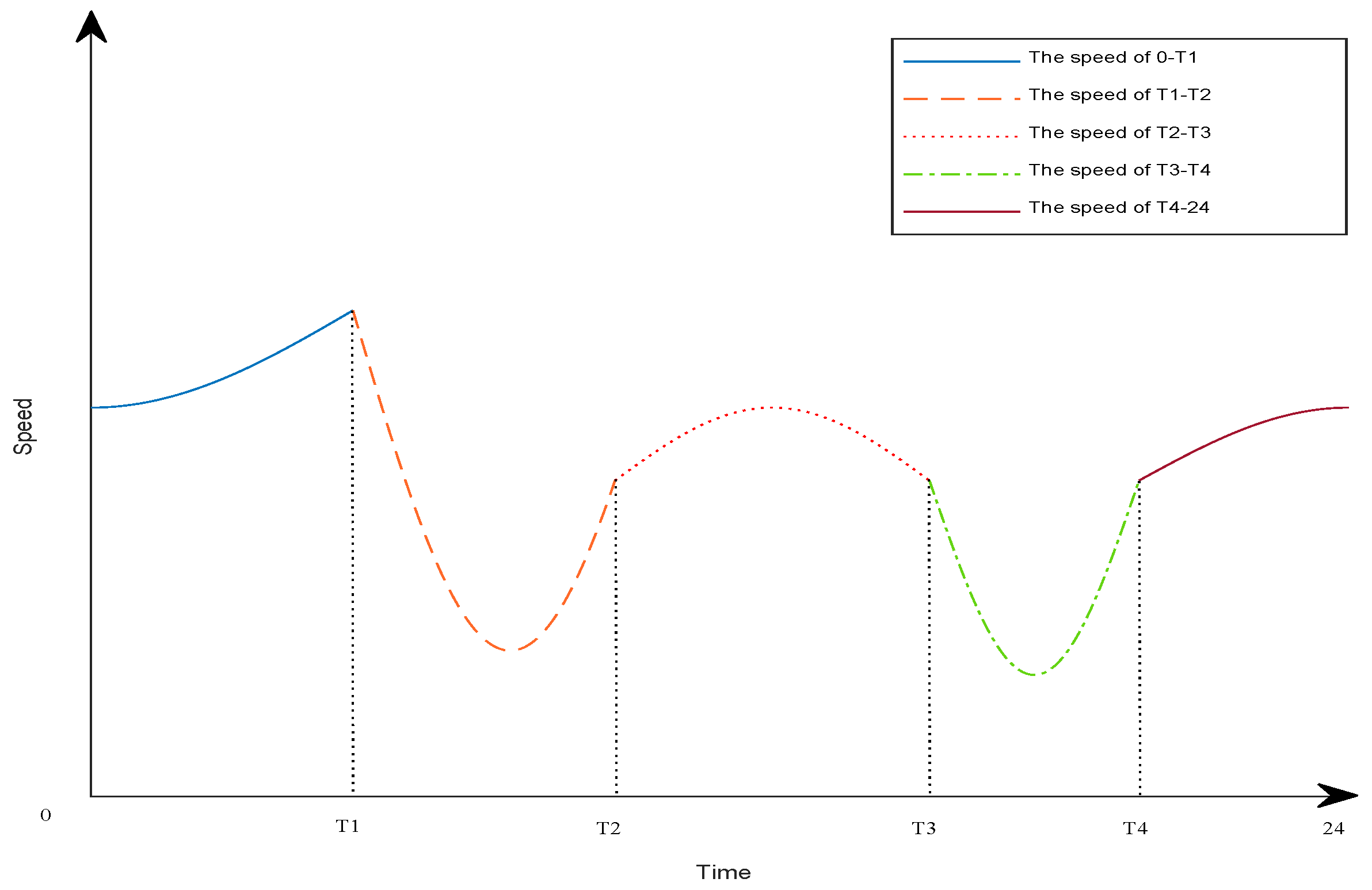


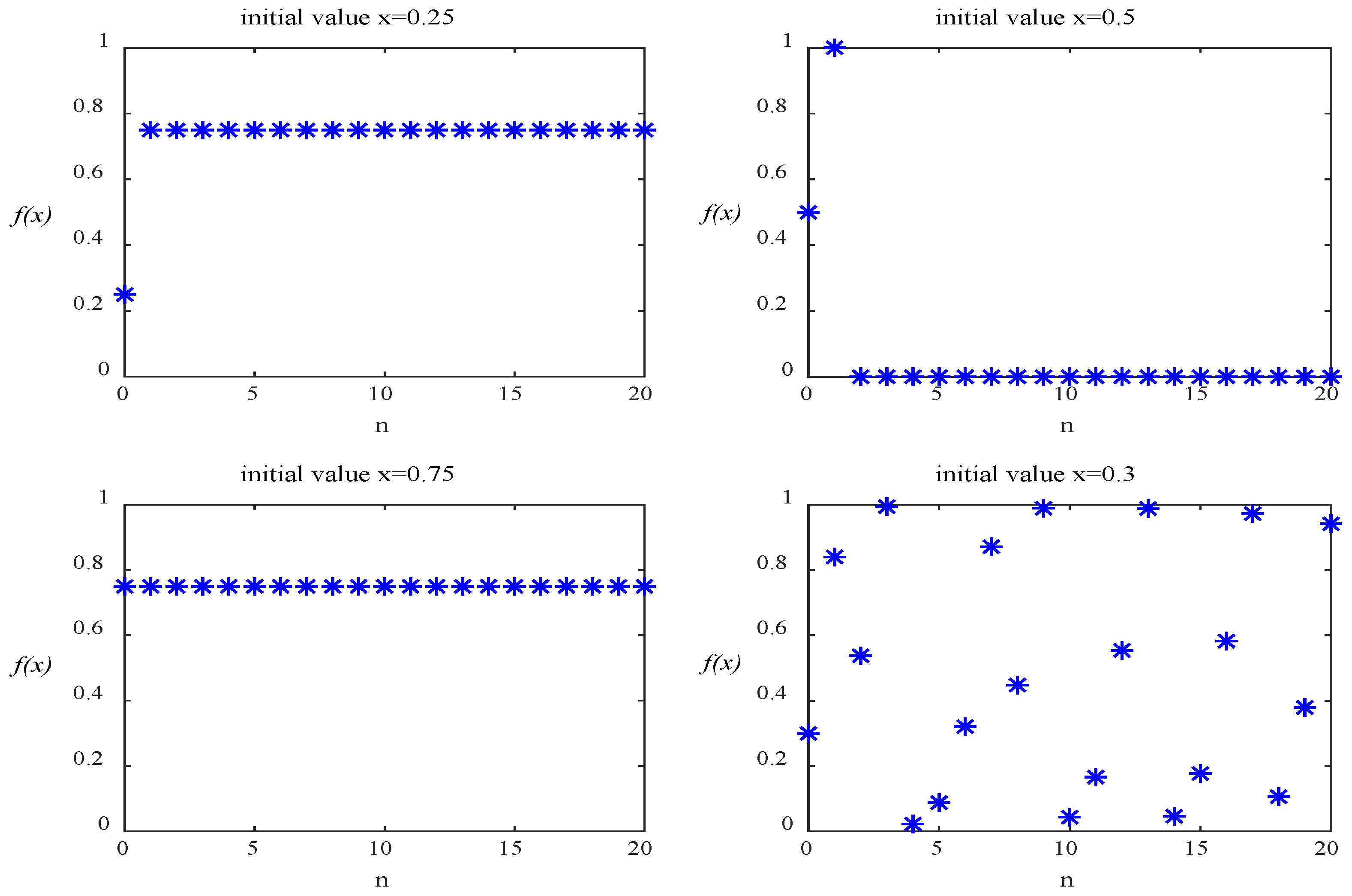
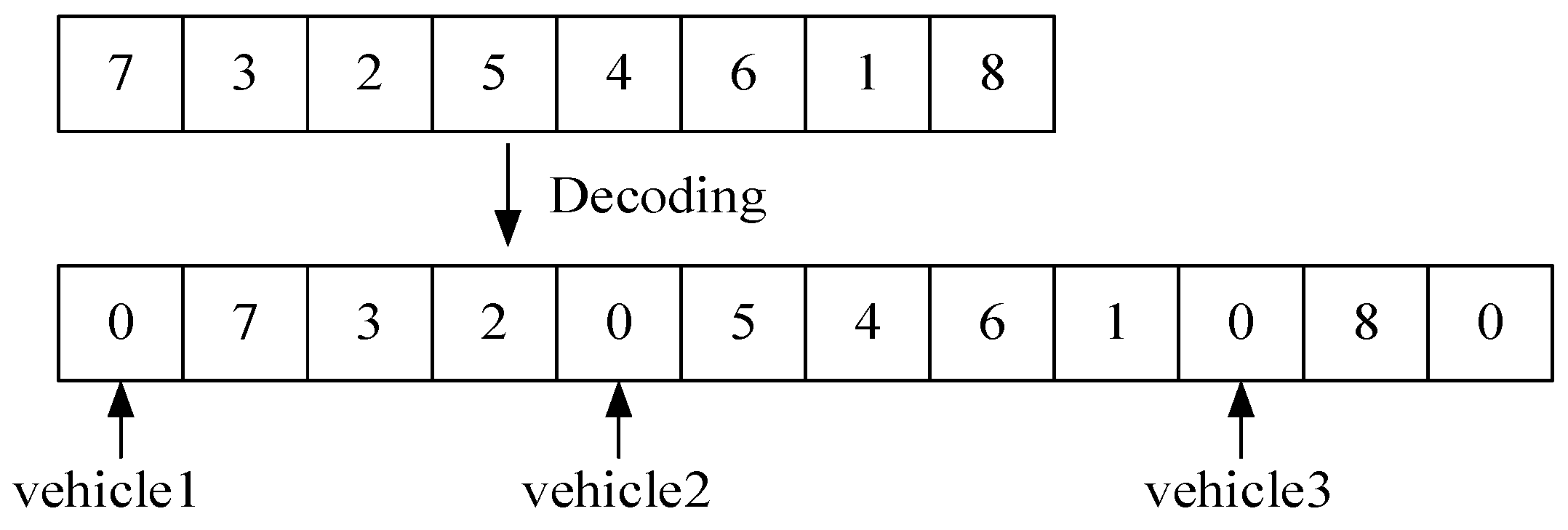

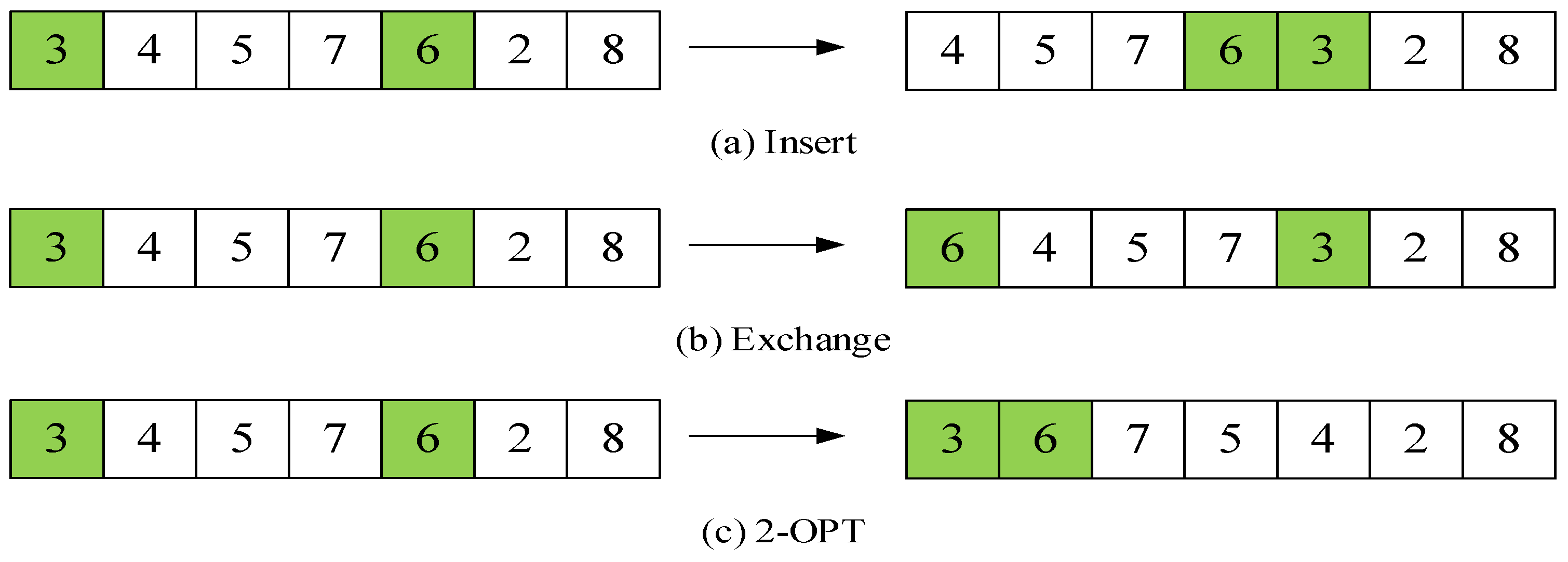
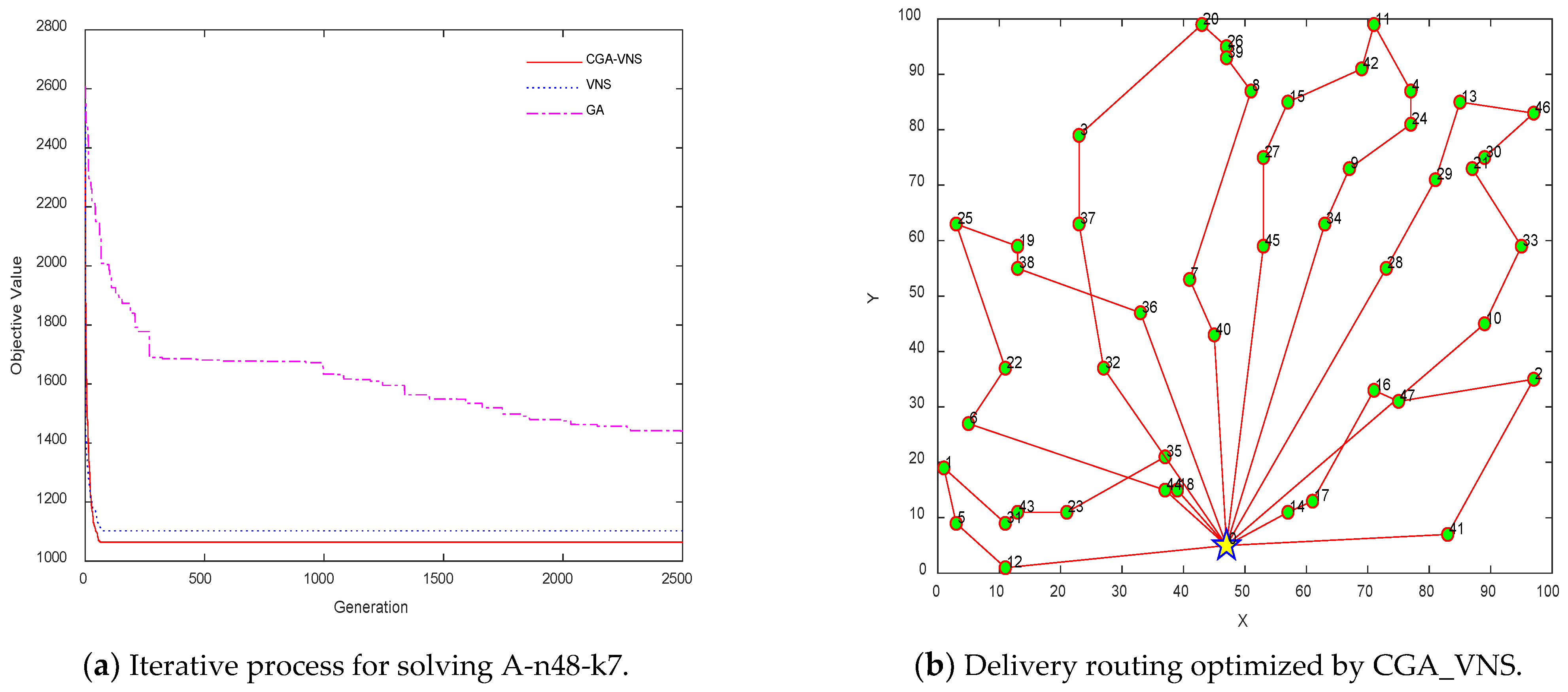


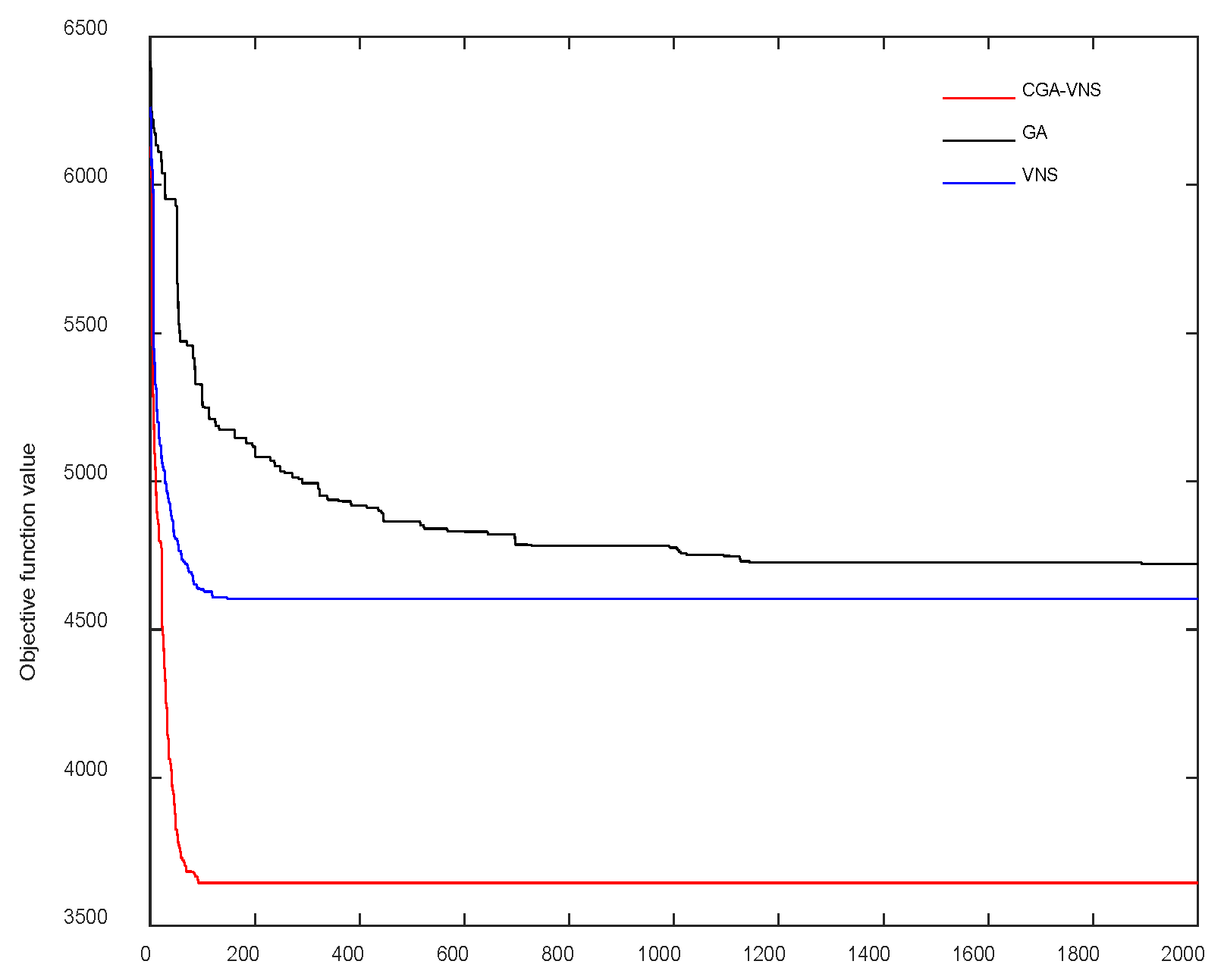
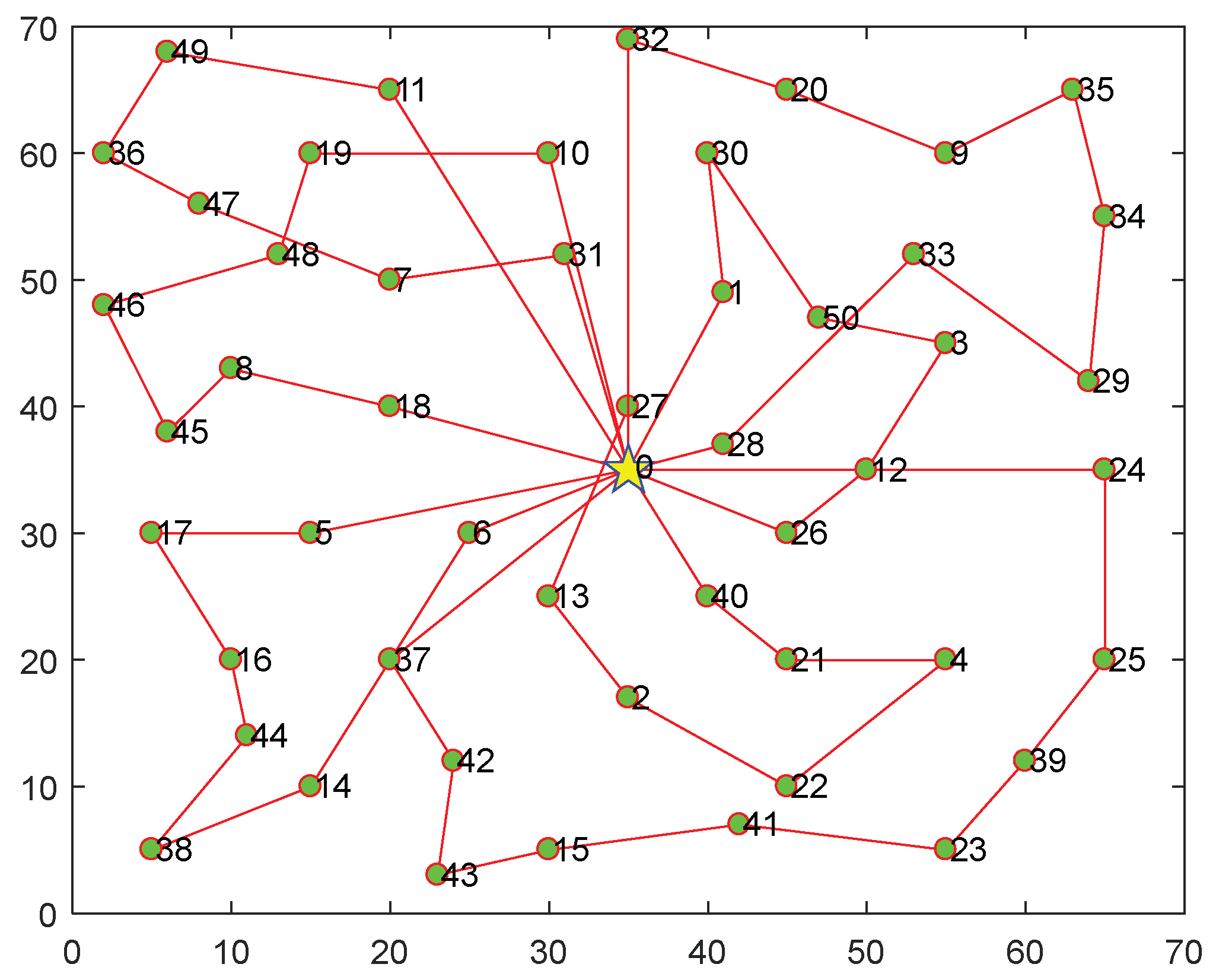
| Instance | VRPHTW | WCA | CGA_VNS | Gap | |||||||
|---|---|---|---|---|---|---|---|---|---|---|---|
| N | D | N | Trans_cost | P_cost | Total_cost | N | Trans_cost | P_cost | Total_cost | ||
| R101 | 19 | 1645.79 | 12 | 1564.49 | 721.20 | 4085.69 | 11 | 1347.89 | 1226.88 | 4224.77 | 3.40% |
| R102 | 17 | 1486.12 | 11 | 1376.37 | 760.00 | 3786.37 | 11 | 1336.07 | 841.29 | 3827.36 | 1.08% |
| R103 | 13 | 1292.68 | 9 | 1141.14 | 1173.76 | 3664.9 | 10 | 1163.59 | 417.57 | 3081.16 | −15.93% |
| R104 | 9 | 1007.24 | 8 | 1017.82 | 811.53 | 3029.35 | 9 | 936.02 | 476.41 | 2762.43 | −8.81% |
| R105 | 14 | 1377.11 | 10 | 1228.63 | 1055.70 | 3784.33 | 10 | 1172.32 | 1113.58 | 3785.9 | 0.04% |
| R106 | 12 | 1251.98 | 9 | 1127.40 | 1395.04 | 3872.44 | 9 | 1041.13 | 1116.56 | 3507.69 | −9.42% |
| R107 | 10 | 1104.66 | 8 | 1066.83 | 1451.95 | 3718.78 | 9 | 1015.70 | 557.93 | 2923.63 | −21.38% |
| R108 | 9 | 960.88 | 8 | 986.88 | 760.24 | 2947.12 | 9 | 946.00 | 198.18 | 2494.18 | −15.37% |
| R109 | 11 | 1194.73 | 9 | 1137.75 | 908.40 | 3396.15 | 10 | 1152.49 | 786.24 | 3438.73 | 1.25% |
| R110 | 10 | 1118.59 | 9 | 1100.66 | 553.29 | 3003.95 | 9 | 1091.81 | 726.84 | 3168.65 | 5.48% |
| Ave_gap | −5.96% | ||||||||||
| α | 0.1 | 0.2 | 0.3 | 0.4 | 0.5 | 0.6 | 0.7 | 0.8 | 0.9 | 1 | t/s | |
|---|---|---|---|---|---|---|---|---|---|---|---|---|
| Instance & Algorithm | ||||||||||||
| A-n36-k5 | CGA_VNS | 711 | 724 | 768 | 770 | 802 | 818 | 851 | 877 | 902 | 902 | 7.3 |
| VNS | 712 | 724 | 779 | 770 | 811 | 831 | 866 | 899 | 902 | 906 | 6.2 | |
| GA | 803 | 835 | 845 | 882 | 879 | 945 | 944 | 965 | 974 | 1007 | 18.21 | |
| A-n44-k7 | CGA_VNS | 852 | 872 | 898 | 933 | 939 | 965 | 1010 | 1031 | 1063 | 1093 | 12.0 |
| VNS | 864 | 872 | 904 | 944 | 949 | 978 | 1030 | 1035 | 1069 | 1108 | 9.5 | |
| GA | 995 | 1079 | 1040 | 1101 | 1131 | 1200 | 1140 | 1184 | 1148 | 1224 | 20.9 | |
| A-n48-k7 | CGA_VNS | 942 | 977 | 1038 | 1064 | 1111 | 1115 | 1179 | 1221 | 1240 | 1267 | 14.1 |
| VNS | 959 | 996 | 1040 | 1075 | 1109 | 1142 | 1224 | 1238 | 1243 | 1309 | 11.4 | |
| GA | 1194 | 1212 | 1264 | 1258 | 1298 | 1301 | 1387 | 1401 | 1407 | 1490 | 25.8 | |
| A-n55-k9 | CGA_VNS | 951 | 992 | 1012 | 1061 | 1082 | 1122 | 1163 | 1178 | 1233 | 1282 | 20.7 |
| VNS | 957 | 1015 | 1025 | 1068 | 1122 | 1157 | 1175 | 1237 | 1246 | 1279 | 17.1 | |
| GA | 1222 | 1295 | 1312 | 1283 | 1331 | 1340 | 1337 | 1433 | 1446 | 1490 | 35.4 | |
| A-n65-k9 | CGA_VNS | 1069 | 1092 | 1121 | 1186 | 1211 | 1266 | 1295 | 1353 | 1417 | 1431 | 26.2 |
| VNS | 1097 | 1096 | 1168 | 1223 | 1259 | 1305 | 1298 | 1373 | 1477 | 1487 | 24.2 | |
| GA | 1484 | 1538 | 1508 | 1525 | 1615 | 1671 | 1741 | 1688 | 1745 | 1706 | 63.8 | |
| A-n69-k9 | CGA_VNS | 1064 | 1106 | 1138 | 1185 | 1195 | 1247 | 1286 | 1313 | 1333 | 1380 | 26.8 |
| VNS | 1072 | 1121 | 1149 | 1241 | 1237 | 1310 | 1321 | 1350 | 1375 | 1390 | 25.6 | |
| GA | 1255 | 1321 | 1483 | 1479 | 1582 | 1547 | 1554 | 1574 | 1610 | 1687 | 71.35 |
| α | VNSS | VNTS | CGA_VNS | t/s | Gap | ||||||
|---|---|---|---|---|---|---|---|---|---|---|---|
| N | Best | Ave | N | Best | Ave | N | Best | Ave | |||
| 0.1 | 4 | 686 | 686 | 4 | 686 | 686 | 4 | 687 | 687 | 4.3 | 0.14% |
| 0.2 | 4 | 719 | 719 | 4 | 719 | 719 | 4 | 719 | 719 | 4.3 | 0 |
| 0.3 | 4 | 727 | 727 | 4 | 727 | 727 | 4 | 727 | 727 | 4.2 | 0 |
| 0.4 | 5 | 755 | 755.7 | 5 | 755 | 755 | 4 | 755 | 755 | 4.5 | 0 |
| 0.5 | 5 | 784 | 784 | 5 | 784 | 784 | 5 | 784 | 784 | 4.3 | 0 |
| 0.6 | 5 | 796 | 796 | 5 | 796 | 796 | 5 | 796 | 796 | 4.2 | 0 |
| 0.7 | 5 | 848 | 848 | 5 | 848 | 848 | 5 | 848 | 851.1 | 4.2 | 0 |
| 0.8 | 5 | 880 | 883.3 | 5 | 868 | 868 | 5 | 868 | 868 | 4.5 | 0 |
| 0.9 | 5 | 882 | 887.6 | 5 | 882 | 882 | 5 | 882 | 882.8 | 4.3 | 0 |
| 1.0 | 6 | 892 | 892.2 | 6 | 892 | 892 | 6 | 892 | 893.3 | 4.4 | 0 |
| α | GA | VNS | CGA_VNS | |||||||||
|---|---|---|---|---|---|---|---|---|---|---|---|---|
| Best/N | Worst/N | Ave | SD | Best/N | Worst/N | Ave | SD | Best/N | Worst/N | Ave | SD | |
| 0.1 | 4170.9/5 | 4198.0/5 | 4188.3 | 12 | 3995.0/5 | 4090.0/5 | 4045.6 | 39 | 3092.4/4 | 3120.4/4 | 3109.7 | 12 |
| 0.2 | 4011.1/5 | 4117.1/5 | 4066.7 | 43 | 3992.5/5 | 4025.5/5 | 4013.3 | 15 | 3067.4/4 | 3106.5/4 | 3091.7 | 17 |
| 0.3 | 3968.8/5 | 4320.8/5 | 4128 | 146 | 3981.4/5 | 4038.3/5 | 4010.7 | 23 | 3622.0/5 | 3650.8/5 | 3640 | 13 |
| 0.4 | 4700.8/6 | 4723.5/6 | 4713 | 9 | 3965.1/5 | 4604.3/6 | 4188.4 | 294 | 3644.8/5 | 3697.3/5 | 3673.9 | 22 |
| 0.5 | 4547.7/6 | 4599.2/6 | 4566.3 | 23 | 4472.0/6 | 4517.4/6 | 4491.6 | 19 | 4249.5/6 | 4311.4/6 | 4272.5 | 28 |
| 0.6 | 5025.6/7 | 5117.9/7 | 5073.8 | 38 | 4994.4/7 | 5042.8/7 | 5013.7 | 21 | 4797.3/7 | 4820.0/7 | 4807.2 | 9 |
| 0.7 | 5030.9/7 | 5058.0/7 | 5045.7 | 11 | 4891.8/7 | 5021.8/7 | 4953.6 | 53 | 4779.7/7 | 4863.1/7 | 4811.8 | 37 |
| 0.8 | 5067.0/7 | 5149.3/7 | 5108 | 34 | 5034.2/7 | 5175.3/7 | 5097.1 | 59 | 4832.3/7 | 4866.3/7 | 4848.8 | 14 |
| 0.9 | 5265.3/7 | 5455.7/7 | 5321.9 | 120 | 5338.9/7 | 5605.3/8 | 5522.6 | 130 | 4912.7/7 | 4958.3/7 | 4936.7 | 19 |
| 1 | 5654.5/8 | 5720.0/8 | 5702.1 | 34 | 5556.6/8 | 5642.0/8 | 5591.5 | 37 | 5402.1/8 | 5426.3/8 | 5409.3 | 12 |
| Ave | 47 | 69 | 18 | |||||||||
| α | Pre-Best | Strategy 1 | Strategy 2 | Strategy 3 | Re-Best | |||
|---|---|---|---|---|---|---|---|---|
| E-Cost | T-Cost | E-Cost | T-Cost | E-Cost | T-Cost | |||
| 0.1 | 3092.4 | 536.8 | 3629.2 | 466.3 | 3558.7 | 327.3 | 3419.7 | 3419.7 |
| 0.2 | 3067.4 | 514.6 | 3582.0 | 460.1 | 3527.5 | 343.6 | 3411.0 | 3411.0 |
| 0.3 | 3622.0 | 544.6 | 4166.6 | 496.8 | 4118.8 | 376.7 | 3998.7 | 3998.7 |
| 0.4 | 3644.8 | 594.5 | 4239.3 | 533.1 | 4177.9 | 276.0 | 3920.8 | 3920.8 |
| 0.5 | 4249.5 | 0 | 4249.5 | 0 | 4249.5 | 0 | 4249.5 | 4249.5 |
| 0.6 | 4797.3 | 0 | 4797.3 | 0 | 4797.3 | 0 | 4797.3 | 4797.3 |
| 0.7 | 4779.7 | 0 | 4779.7 | 0 | 4779.7 | 0 | 4779.7 | 4779.7 |
| 0.8 | 4832.3 | 0 | 4832.3 | 0 | 4832.3 | 0 | 4832.3 | 4832.3 |
| 0.9 | 4912.7 | 0 | 4912.7 | 0 | 4912.7 | 0 | 4912.7 | 4912.7 |
| 1 | 5402.1 | 0 | 5402.1 | 0 | 5402.1 | 0 | 5402.1 | 5402.1 |
| Pre-Optimization Scheme | Strategy 1 | Strategy 2 | Strategy 3 |
|---|---|---|---|
| V1: 0-27-31-7-11-32-33-3-29-24-25-26-0; | V1: 0-27-31-7-11-32-33-3-29-24-25-0-25-26-0; | V1: 0-27-31-7-11-32-33-3-29-24-0-25-26-0; | V1: 0-27-31-7-11-32-33-3-29-24-0; |
| V2: 0-28-12-4-39-23-22-21-0; | V2: 0-28-12-4-39-23-22-0-22-21-0; | V2: 0-28-12-4-39-23-0-22-21-0; | V2: 0-28-12-4-39-23-0; |
| V3: 0-18-8-47-36-49-19-20-9-35-34-0; | V3: 0-18-8-47-36-49-19-20-9-35-0-35-34-0; | V3: 0-18-8-47-36-49-19-20-9-0-35-34-0; | V3: 0-18-8-47-36-49-19-20-9-0; |
| V4: 6-5-17-45-46-48-10-30-50-1-0; | V4: 6-5-17-45-46-48-10-30-50-0-50-1-0; | V4: 6-5-17-45-46-48-10-30-0-50-1-0; | V4: 6-5-17-45-46-48-10-30-0; |
| V5: 0-40-2-41-15-43-42-14-44-38-16-37-13-0; | V5: 0-40-2-41-15-43-42-14-44-38-16-37-13-0-13-0; | V5: 0-40-2-41-15-43-42-14-44-38-16-37-0-13-0; | V5: 0-40-2-41-15-43-42-14-44-38-16-37-0; |
| V1′: 0-25-13-22-21-26-0; | |||
| V2′: 0-34-25-1-50; |
Publisher’s Note: MDPI stays neutral with regard to jurisdictional claims in published maps and institutional affiliations. |
© 2022 by the authors. Licensee MDPI, Basel, Switzerland. This article is an open access article distributed under the terms and conditions of the Creative Commons Attribution (CC BY) license (https://creativecommons.org/licenses/by/4.0/).
Share and Cite
Fan, H.; Ren, X.; Zhang, Y.; Zhen, Z.; Fan, H. A Chaotic Genetic Algorithm with Variable Neighborhood Search for Solving Time-Dependent Green VRPTW with Fuzzy Demand. Symmetry 2022, 14, 2115. https://doi.org/10.3390/sym14102115
Fan H, Ren X, Zhang Y, Zhen Z, Fan H. A Chaotic Genetic Algorithm with Variable Neighborhood Search for Solving Time-Dependent Green VRPTW with Fuzzy Demand. Symmetry. 2022; 14(10):2115. https://doi.org/10.3390/sym14102115
Chicago/Turabian StyleFan, Hao, Xiaoxue Ren, Yueguang Zhang, Zimo Zhen, and Houming Fan. 2022. "A Chaotic Genetic Algorithm with Variable Neighborhood Search for Solving Time-Dependent Green VRPTW with Fuzzy Demand" Symmetry 14, no. 10: 2115. https://doi.org/10.3390/sym14102115
APA StyleFan, H., Ren, X., Zhang, Y., Zhen, Z., & Fan, H. (2022). A Chaotic Genetic Algorithm with Variable Neighborhood Search for Solving Time-Dependent Green VRPTW with Fuzzy Demand. Symmetry, 14(10), 2115. https://doi.org/10.3390/sym14102115




